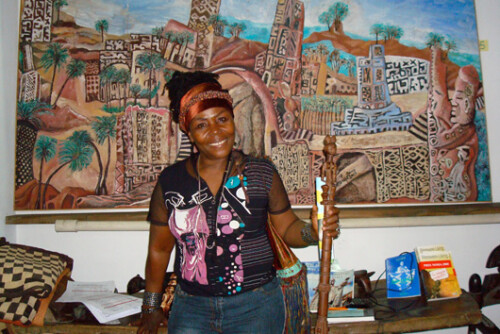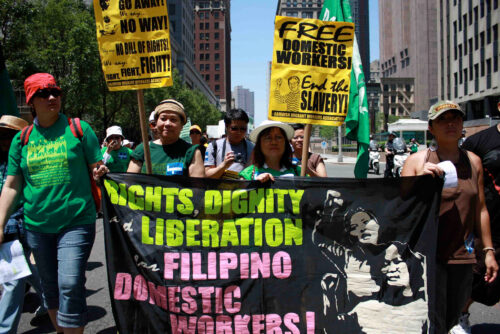In the last two decades, growing numbers of middle-class households in the U.S. have included domestic workers, mostly of Latin American origin or ancestry.1 This has contributed to a downward economic shift in Hothschild’s crisis of reproductive labor, bringing the “who’s watching the kids?” question to a greater number working-class households in the U.S. and across national boundaries, as mothers leave young children in their home countries to support them by doing domestic work elsewhere. This is a “cost of reproductive labor” issue. If an increasing number of middle-class households in the U.S. are relying on labor from elsewhere (i.e., from Latin American women hired for lower wages to work in their homes), then it is also true that migrant women who leave their children in home countries are relying on the lower cost of reproductive labor outside of the U.S.2 It is a form of “offshore reproduction” that has been, at once, crucial to other forms of globalization, including the superheating of the U.S. economy before the crash of 2008, and, to a significant extent, ignored in discussions of neoliberal globalization.
While there was never a golden age in the U.S. when domestic labor was understood to be a common, social concern supported by the state and a wider community, there were still moments that offered a promise of something different. In the 1960s and ’70s, feminism and the welfare rights movement advocated wages for motherhood, housework, and daycare centers. Jimmy Carter’s administration even acknowledged some obligation to help families with young children since, for the first time, a majority of mothers of children under six were working for wages.3) Reagan changed all of that. Beginning with the 1980 campaign focus on “welfare cheats,” it was high on the agenda of Reagan’s people to shut this space down. How they did this was a textbook case for neoliberalism: they began by demonizing working-class black, Latina, and Native women and children as irresponsible, immoral, and unworthy of help. Then, they moved on to white middle-class families, which they claimed were potentially just like these awful working-class families of color—or that they would become like them if government gave them support. In place of this, neoliberals offered personal responsibility and security. I am thinking, here, of how “crack babies,” fetal alcohol syndrome, and child car seats and bike helmets became major public policy issues.
I have written about the invention of the crack baby in the 1980s and how it was part and parcel of the civic disenfranchisement and sanctioned impoverishment of black and Latino people in the U.S.4 Here, I want to talk about fetal alcohol syndrome (FAS) because it caused double damage: it first demonized Native American mothers and then turned on (usually white) middle-class mothers. Together, “crack babies” and FAS provided a cover story for neoliberal decimation of the social contract between the state and its most vulnerable citizens, essentially claiming that personal irresponsibility was illegitimately making outrageous claims on the public fisc.
In 1989, Michael Dorris published The Broken Cord, an influential account of Fetal Alcohol Syndrome.5 While fetal alcohol syndrome had been identified in the research literature as early as 1973 and had received passing mention in the media and in court cases, Dorris’s book put it on the map as a public health emergency. The first half of Broken Cord is a tremendously compelling, novelistic account of the adoption of his son, a toddler with developmental delays, and the crashing to earth of Dorris’s hopes that environment was everything, as his son continued to exhibit growing health problems and learning disabilities. By the end of the book, Dorris insists that as many as one in three Native children may have been irredeemably harmed by maternal drinking during pregnancy. What followed was hysteria about pregnant women drinking, culminating in warning labels on alcoholic beverages and in bars. Media stories decried child abuse and even “genocide” by Native American women who drank. Women, mostly Native, went to jail to “protect” their fetuses, despite appalling pregnancy outcomes for women in prison, and some lost children to foster care. Native children with developmental disabilities were automatically assumed to have FAS, although a 1994 genetic study on reservations in Arizona found that more than half the children diagnosed with FAS didn’t have it, suffering instead from Down’s syndrome or something similar.6
The entire debate also terrified middle-class women who didn’t drink much. Fetal alcohol syndrome went from being a problem of the children of alcoholic women to a warning to all pregnant women not to drink at all. Uncertainty about how much alcohol caused fetal defects emboldened public health officials and the media to claim that any alcohol use at all during pregnancy constituted fetal child abuse.7 Dorris’s partner, Louise Erdrich, summed it up when she said that “one-glass-of-wine-a-day permissiveness of first-time yuppie mothers is still sufficient to cause brain damage in the fetus.”8 No one has the slightest idea if that is true.
Yuppie mothers in the ’80s were never demonized the way that black or Native mothers were. Still, for them, the ’80s was a period of intensifying anxiety about their vulnerable children. Child advice books turned mean.9 In contrast to the reassuring Dr. Spock, who told mothers that if they listened to their children and their own common sense, all would be fine, mothers in the ’80s got Richard Ferber and T. Berry Brazelton. The new advice books warned of the dangers of bad parenting, urged disciplined approaches to bedtime and potty-training, and insisted that parents attend to developmental guideposts. The 1980s also marked the emergence of a host of new anxieties about child death and disability (ironically as rates of both declined). There were countless news stories about threats to children, including SIDS,10 unverifiable reports of poisoned Halloween candy, drunk driving, stranger kidnapping, and sexual abuse. States passed new laws requiring bicycle helmets for children,11 seat belts, and expensive child safety seats.12 At exactly the moment when middle-class U.S. American mothers most needed them, sturdy, self-reliant children disappeared.13 At a time when there might have been a widespread demand for publicly-funded daycare, daycare became seen as a dangerous place where children were routinely sexually abused. The 1980s expansion of the private was at once an attack on feminism and the incursion of neoliberalism, replacing belief in public services with private, familial labor.
- A number of people have made this point; see e.g. Pierrette Hondagneu-Sotelo and Ernestine Avila, “I’m Here, but I’m There: The Meanings of Latina Transnational Motherhood,” Gender and Society 11, no. 5 (1997); Hondagneu-Sotelo, Doméstica : Immigrant Workers Cleaning and Caring in the Shadows of Affluence. The Bureau of Labor Statistics in 2006 counted 37.2% Latino or Hispanic “maids or housekeeping workers,” and 19.9% African-American. It recorded no nannies, but “childcare workers” were 17.3% Latina and 17% Black. Bureau of Labor Statistics, “Employed Persons by Detailed Occupation, Sex, Race and Hispanic Origin,” (Washington, DC: Bureau of Labor Statistics, 2007). (It also found this to be the segment of the employed population most likely to be poor). Bureau of Labor Statistics, “A Profile of the Working Poor,” (Washington, D.C.: Department of Labor, 2000). [↩]
- Rhacel Salazar Parreñas, Children of Global Migration: Transnational Families and Gendered Woes (Stanford: Stanford University Press, 2005). [↩]
- My favorite invocation of these politics is Barbara Ehrenreich’s outraged questions about what happened to them as she encountered resistance from feminists to her discussion in her New Yorker article about the humiliating sexual politics of “maid” work. See Barbara Ehrenreich, Nickel and Dimed: On (Not) Getting by in America, 1st ed. (New York: Metropolitan Books, 2001). There is a fabulous new literature on welfare rights; see Annelise Orleck, Storming Caesars Palace: How Black Mothers Fought Their Own War on Poverty (Boston: Beacon Press, 2005); Felicia Ann Kornbluh, The Battle for Welfare Rights: Politics and Poverty in Modern America (Philadelphia: University of Pennsylvania Press, 2007). Peter N. Stearns, Anxious Parents: A History of Modern Childrearing in America (New York; London: New York University Press, 2003); Patricia Hill Collins, “Shifting the Center: Race, Class, and Feminist Theorizing About Motherhood,” in Mothering: Ideology, Experience, and Agency, ed. Evelyn Nakano Glenn, Grace Chang, and Linda Rennie Forcey (New York: Routledge, 1994); Bonnie Thornton Dill, “Our Mothers’ Grief: Racial-Ethnic Women and the Maintenance of Families,” Journal of Family History 13 (1988); Evelyn Nakano Glenn, “Social Constructions of Mothering: A Thematic Overview,” in Mothering: Ideology, Experience, and Agency, ed. Evelyn Nakano Glenn, Grace Chang, and Linda Rennie Forcey (New York: Routledge, 1994 [↩]
- Laura Briggs, “Orphaning the Children of Welfare: ‘Crack Babies,’ Race, and Adoption Reform,” in Outsiders Within: Writing on Transracial Adoption, ed. Jane Jeong Trenka, Julia Chinyere Oparah, and Sun Yung Shin (Cambridge, Mass.: South End Press, 2006), 2. [↩]
- Michael Dorris, The Broken Cord, 1st ed. (New York: Harper & Row, 1989). [↩]
- Jane Erikson, “Doctors Mislabel Defects: Fetal Alcohol Misdiagnosed,” Arizona Daily Star, November 27, 1995; HE Hoyme, L Hauck, and DJ Meyer, “Accuracy of Diagnosis of Alcohol Related Birth Defects by Non-Medical Professionals in a Native American Population” (paper presented at the David W. Smith Morphogenesis and Malformations Workshop, Mont Tremblant, Québec, CANADA, 1994). In a personal communication, Hoyme sent me the paper but told me he never published the research. [↩]
- Janet Golden, “An Argument That Goes Back to the Womb”: The Demedicalization of Fetal Alcohol Syndrome, 1973-1992,” Journal of Social History 33, no. 2 (1999). [↩]
- Charles Trueheart, “Marriage for Better or Words: The Dorris-and-Erdrich Team, Creating Fiction Without Friction,” Washington Post, 19 October 1988. [↩]
- Rima D. Apple, Perfect Motherhood: Science and Childrearing in America (New Brunswick, N.J.: Rutgers University Press, 2006). Argues that Spock is contradictory and that, on the one hand, he tells mothers to trust themselves, while on the other, he continues to inculcate the reign of the expert doctor, the one who really knows. Fair enough. But as she also notes, he is at a minimum a lot more friendly than the earlier advice books, precisely because he tells mothers to trust themselves. For the post-Spock period, Apple says there is a vastly expanded number of experts offering incredibly heterogeneous advice. Perhaps. But I disagree that there is no orthodoxy; in my experience, even casual conversations with people over 30 reveals a remarkable unanimity in opinion that those who became parents in the decades after 1990 are far more anxious than the generation before. [↩]
- Stearns, Anxious Parents. [↩]
- James D. Sargent, Magda G. Peck, and Michael Weitzman, “Bicycle-Mounted Child Seats and Injury Risk and Prevention,” American Journal of Disease of the Child 142 (1986). And www.nhtsa.dot.gov/people/injury/New-fact-sheet03/BicycleHelmetUse.pdf. [↩]
- Leavitt, Freakonomics. [↩]
- Stearns, Anxious Parents; Steven Starker, Oracle at the Supermarket (New Brunswick, NJ: Transaction Publishers, 1989). [↩]




